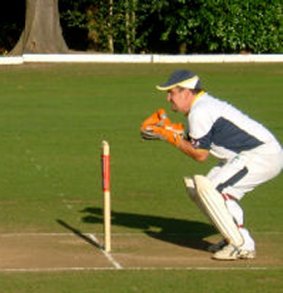
 |
| Index | ||||||
|
Wicket-keeper, Stumper, Keeper  The wicket-keeper is the most specialised of the fielders and is the only one of them permitted to wear gloves and external pads He is only permitted to wear these while either standing in a normal position for a wicket-keeper or running to field the ball. So if the captain were to move his wicket-keeper to field at, say, square-leg, the wicket-keeper would not then be in a 'normal position' for a wicket-keeper. In fact he would have become a fielder just like any other and, under the Laws, would consequently not be allowed to wear gloves or external leg guards The Laws also constrain the wicket-keeper's movement. He must remain completely behind the wicket from the moment the ball comes into play until either it has hit the striker's bat or person, the striker attempts a run, or the ball passes the wicket. If the wicket-keeper breaks this Law (often referred to as the wicket-keeper encroaching) the striker's end umpire should call and signal No ball The striker is entitled to know where the wicker-keeper is standing, so the wicket-keeper is not permitted to make what is called significant movement between the time the bowler starts running up and the ball reaching the striker. While the wicket-keeper can take a pace or two forward if he spots a slower delivery, he is not allowed, for instance, to stand back from the stumps and then run up to them while the bowler is running in to bowl. Either umpire should call and signal Dead ball if he spots the wicket-keeper doing this Nor is the wicket-keeper allowed to interfere, whether accidentally or on purpose, with the striker's right to play the ball and defend his wicket. If any interference is accidental the umpire should call and signal Dead ball; if deliberate he should also issue a first and final warning. If it happens again deliberately the umpire should award 5 Penalty runs to the batting side and inform the appropriate authority later on If, while playing the ball or trying to defend his stumps, the striker interferes with the wicket-keeper, he should not be given out unless he obstructs a possible catch from being taken Regulations have recently been introduced covering the design of wicket keeping gloves to curb the tendency for them to become more 'pouch-like' | ||||||